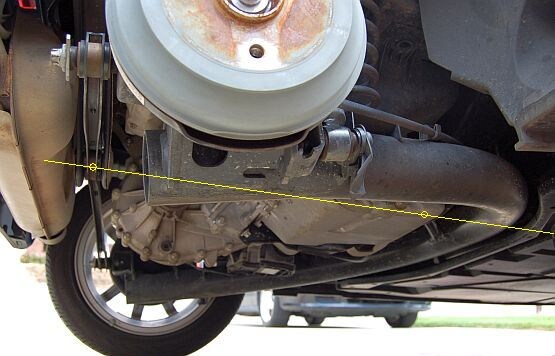
Today we're peeking into the wheelwells of our Smart Fortwo Passion Coupe. This ought to be good.
Because this is an unconventional machine, we're changing things up by starting with the rear suspension, where all of the magic fails to happen.

Not much to see in this view. It's got drum brakes (black) and a coil spring (white). But what's this? There's only one lateral link (yellow) and this big curved beam (green).
That thing hanging down in the middle of the frame is the oil filter. Straddle road debris at your own risk. You've been warned.

What we have here is what's called a De Dion axle, a design invented by Count De Dion in the late 1800's, shortly after the birth of the automobile.
The humungous curved green beam is has a large cross-section because they don't want it to flex, quite unlike the twist beam in our Honda Fit. A De Dion axle is a non-independent solid beam axle.
Trucks have solid beam axles that carry the differential and drive axles within them. They call that a "live axle". A De Dion rigid beam does not carry the differential (orange) or drive axles, so it's called a "dead axle". As such, there is less unsprung mass to muck things up--but not a lot less. Two lateral links (yellow) keep this one centered at the rear. More on that later.

The 1920's Miller front-drive race car turned a lot of heads and won a lot of races. Its prominent De Dion axle curves dramitically ahead of the front-drive mechanicals, drive axles and (inboard!) brakes. This one is supported by quarter-elliptical leaf springs in two places.

The Smart's De Dion axle pivots on a single point, another critical difference from our Honda Fit's twist beam, which pivots on two widely-spaced points.

Here I've approximated the roll axis, with tiny yellow circles indicating the pivot points. There are actually two rear pivots, but the two lateral links are so close together that we can treat them as one here. The forward pivot is the one we saw in the previous picture.
The wheels and De Dion axle stay fixed in relation to the ground, with the body (and engine) rolling above it in turns. Camber and toe are unchanging, which is great if you have bias tires (as they did in the old days) but less than ideal for modern radials that thrive on independent suspension.
Having a hard time visualizing this? Check this out:

OK, this motorcycle-esque machine leans the other way in turns. And it's probably not a De Dion setup because the engine just has to be located in the non-leaning part. But it does illustrate how the body leans above a DeDion axle while the tires stay bolt upright.
A non-independent suspension with an unchanging and unimaginative camber curve does not make for memorable ride comfort or handling. It's easy to see why the Smart has won few friends in this department. Smart used it the De Dion concept anyway because it allowed them to package the car very tightly, which was the whole point going into the project.

Compared to the rear, the Smart's diminutive front suspension is much more familiar. It's a basic strut set-up, with a steel lower a-shaped lower control arm (yellow). There's a stabilizer bar (blue) and a forward-mounted steering rack. The front disc brakes employ non-vented rotors (black).

The stabilizer bar is direct-mounted to the strut (white) with a slender link (salmon).

Despite an all-steel and iron suspension, our Smart weighs only 1804 lb, with less than 800 lb of that on the front axle. The sprung mass is even lower. It all boils down to only 350 lbs or so at this point, plus a portion of the weight of the occupants. That doesn't amount to much, so these skinny coils are all that's needed to keep it all off the ground.

All of this takes place mere inches behind the front bumper, so there isn't much room to work with. The white arrow indicates the radiator and radiator hose, and this sits just forward of the stabilizer bar (blue) which mounts to the control arm pivot bolt (yellow) to save space and money.
A forward-mounted steering rack (orange) is easy to pull off here because there are no front drive mechanicals in the way. Besides, a forward placement is mandatory so the driver and passenger have someplace to put their feet.

The front brake calipers (green) are tiny, too. These are Bosch single-piston sliding calipers. And you thought they only made spark plugs.
The black arrow indicates a bit of extra metal that seems to serve no purpose, which means its purpose is to be a mass damper to change the harmonic frequency of the caliper frame to avoid noise.
This tiny car has tiny wheels and tires, and the 155/60R15 tires and 4.5 x 15 rims that bolt onto this front hub weigh 24 lbs. The rear tire is a "massive" 175/55R15 on a 5.5 x 15 rim, and the assembly weighs 31 lbs.
Dan Edmunds, Director of Vehicle Testing @ 16,235 miles